#hôpital general
Explore tagged Tumblr posts
Text

Urgences du General Hospital Montreal
Montréal, au milieu d’une nuit de juin 2024. Montreal, in the middle of a night of summer 2024. 3/3
Photo : © Julien Rouvel See you on Threads ○ Instagram ○ Behance ○ Dribbble ○ X
#photography#julien rouvel#shots on sight#street photography#montreal#photographers on tumblr#mtl#514#street life#general hospital#hospital#hôpital#urgence#ER#emergency#don’t worry I’m ok#symétrie#chair#wheelchair#mtlphoto#white#mtlmoments
0 notes
Text

"Cérémonie de la pose de la pierre angulaire de l'hôpital S.-Mary," La Presse. June 19, 1933. Page 12. --- Photographies prises samedi matin lors de la cérémonie de la pose de la pierre angulaire du nouvel hôpital S-Mary, situé à l'angle du chemin de la Côte-des-Neiges et de l’avenue Lacombe. La photographie de haut représente Son Excellence Mgr Georges Gauthier parlant au microphone avant de bénir la pierre. A sa droite, on remarque M. Jules Derome, du poste CKAC. Dans la photographie du bas, on voit quelquesuns des nombreux dignitaires qui assistaient à la cérémonie. De gauche à droite: Son Honneur le maire Fernand Rinfret; Lord Bessborough, gouverneur-général du Canada; T. Taggart-Smyth, président du conseil de direction de l'hôpital; Son Excellence Mgr Gauthier et l'abbé Romuald Chayer, secrétaire de Son Excellence. (Clichés la "Presse").
#montreal#new hospital#hôpital saint-mary#cornerstone laying#opening ceremony#cote des neiges#governor general of canada#lord bessborough#bishop of montreal#roman catholic church#great depression in canada#history of canadian health care
0 notes
Text
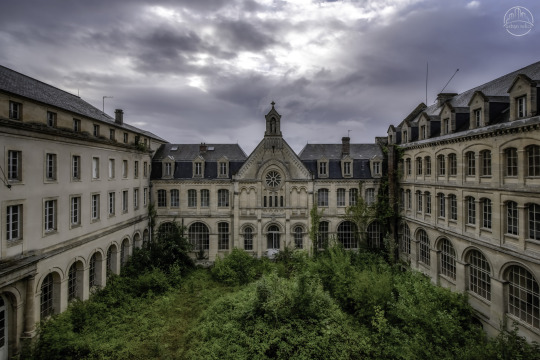
HOPITAL PLAZA
This imposing ensemble, commissioned by the French King Louis XVIII in 1820, is known in urbex circles as 'Hôpital Plaza', although it was only effectively used as a hospital for a very short period at the end of the First World War. During that period, more than 8,000 - mainly Belgian - wounded soldiers were cared for.
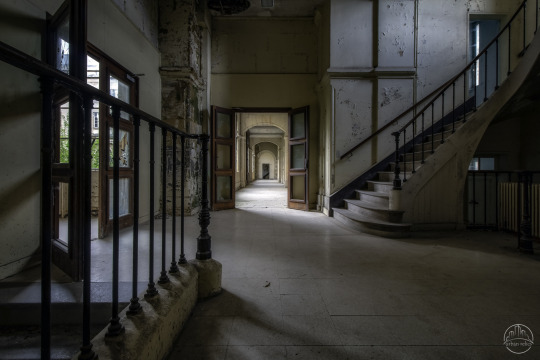
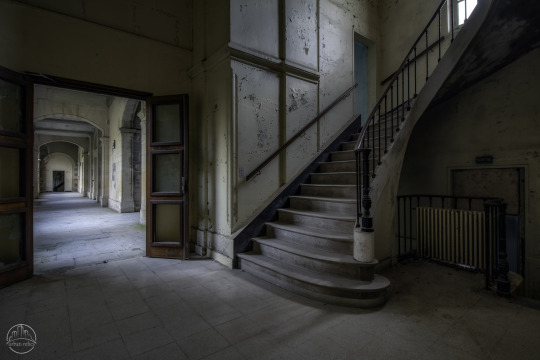
After the French Revolution, the Catholic fire again raged very strongly in the west of France, especially in Normandy, and there was a need for training opportunities for young men who felt called to the priesthood. Two wealthy residents donated the necessary land to the diocese to establish a "minor seminary" on this site. The ensemble became an architectural replica of the nearby 'major seminary'. Young seminarians first followed a course here, after which they completed their training in the major seminary.

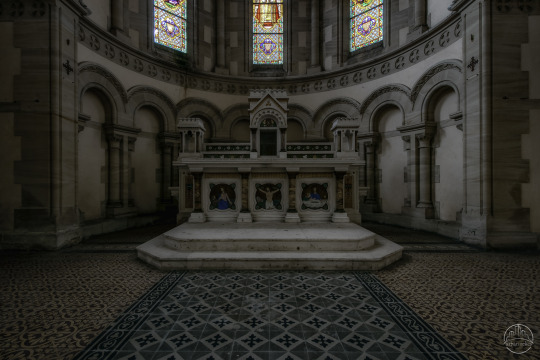

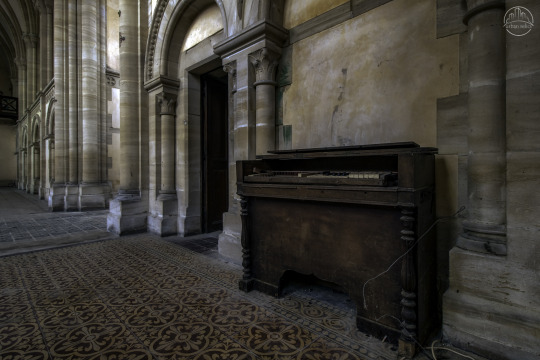

The Minor Seminary not only welcomed young people who were destined for the priesthood; it also gave access to general education, both for sons of wealthy families and those of families from more humble backgrounds. The school survived until 1905, when the French church and state were once again separated.
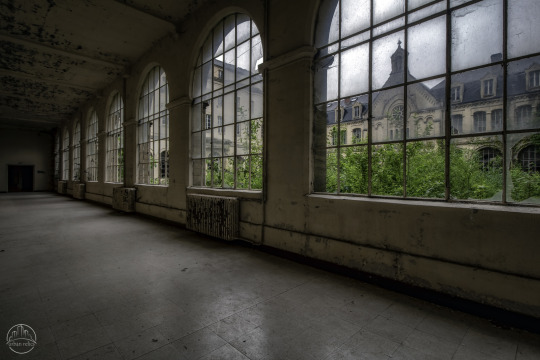


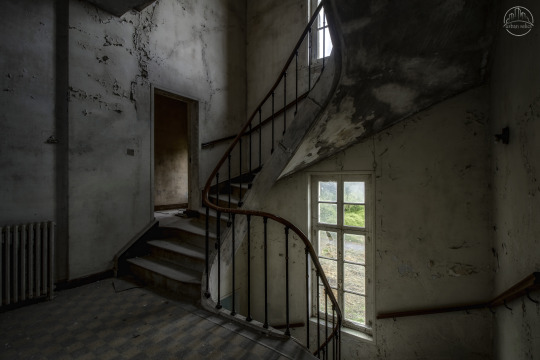
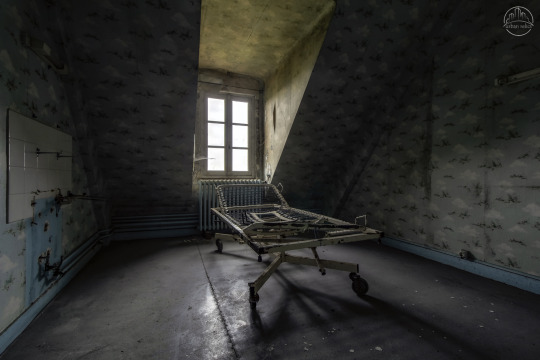

At the end of the First World War, the building became a shelter for veterans. After all, at the end of the fighting, many disabled soldiers could no longer support themselves. The Minor Seminary became a home to welcome them. Retired veterans joined later. Many affected French families also found temporary shelter here during the Second World War, after which the buildings resumed their function as a retirement home for veterans.
In June 2000, it was abandoned completely and was sold to a businessman from Lyon, who intended to install 70 luxury apartments. Much to the chagrin of the local government, the plans were never realized and the old seminary began to deteriorate. Since 2016 it has been owned by Spanish property developers, who were supposed to look for a new destination. The local government now wants to start an 'abandonment' procedure to expropriate the whole ensemble, hoping to give the beautiful seminary a new lease on life.


#urban exploration#urbex#abandoned#urban relics#decay#derelict#abandoned places#ue#photography#urbanexploration#france#photographer#hopital#plaza
157 notes
·
View notes
Text
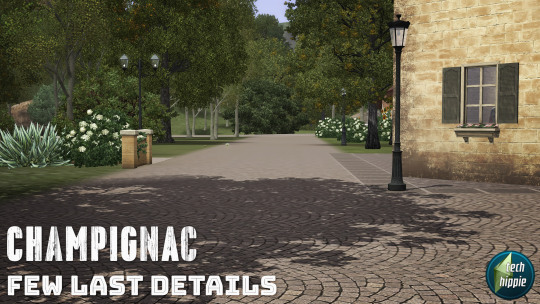
CHAMPIGNAC ... FEW LAST DETAILS :)
And of course, we have some mistakes in the links and in the cc content we are currently correcting ... What is a good Sims 3 World without a little headache ? :D And because we love difficulties, we are currently updating our own website ( which is a mess ) ... What else ? Nothing, everything is fine under the sun of this hot summer :D
The General Hospital is a Maxis one, but from Riverview. @nornities ( thanks A LOT for his/her patience to check Champignac ) pointed to us different things : missing mostly. so, somes of you may not see the Hospital ( Hopital des Bleuets ) in their game.
Bad links are currently corrected and both CC sims3packs folder and CC packages folder updated to include few missing stuff, including the Fresco Market items and the Skylight Studio roof elements we used + the Riverview Hospital :) HERE
The Open Swimming pool ( Champignac Bains Romains ) has lost its border texture ... don't worry : just replace with a one you like :)
The School is not the good one : too many missing stuff there, so we are currently uploading a new Champignac save game which should correct the little mistakes here and there HERE
Our Carpets Rabbit Holes folder had to be updated to get the Bistro RH : it is currently done ! But, you have to re-download the Rabbit Holes HERE
Our apologizes for this ! Really ... Anyway, we'll upload in the next hours a folder with ALL Community Lots and another one with ALL the residential Lots :) Just in case ... And here the 2 listings :

CHAMPIGNAC COMMUNITY LOTS
Small Park : Monticule funéraire oublié - Colline des Celtes Small Park : Petit Fleuriste Small Park : La Vieille Tour no1 Small Park : La Vieille Tour no2 Small Park : Place Olivier Magnolia Horse Training Grounds : Elevage Pégase Junkyard : Neo Casse Stadium : Football Club Fire Station : Pompiers Volants Pool : Piscine Municipale Pool : Bains Romains de Champignac Diner : Brasserie du Cercle Gym : Gymnase Club Visitor Allowed : Boulangerie DeNimes Elixir Shop : Boutique d’élixirs : Elixirs et Reliques Theatre : Théâtre & Opéra Cemetary : Cimetière Civil Hospital : Hôpital des Bleuets Bookstore : Le Kiosque no5 Library : Bibliothèque V. Hugo Café : Café Catane Military Base : Bureau des Armées Police Station : Police Municipale Grocery Store : Epicerie des Halles Market : Marché Bio City Hall : Nouvelle Mairie Art Gallery: Villa Medicis Fishing Spot : Lac des Collines Criminal Hideout : Cyber Crime Beach : La Petite Plage Gypsy Wagon : Oeil d’Irma Science Lab : Bio Sciences Supernatural Hangout : Taverne du Nain Business & Journalism : Centre d’Affaires Consignment Store : Boutique & Brocante Bistro : Bistro Gastronomie Nectary : Le Monastère School : Ecole Municipale Vampire Bar & Cocktail : Midnight Lounge

CHAMPIGNAC RESIDENTIAL LOTS
Maison Familiale : 1 double bed + 2 single bed Maison Bleu Indigo : 1 double bed Maison des Pensées : 2 double bed + 2 single bed Maison des Prés : 3 double bed + 1 single bed Maison Ensoleillée : 1 double bed + 1 single bed Maison des Colocs : 2 double bed Maison Élégante : 2 double bed + 2 single bed Maison Tournesol : 1 double bed + 1 single bed Maison Biscornue : 2 double bed + 1 single bed Maison des Haies : 1 double bed + 2 single bed Maison Neo Rustique : 1 double bed + 1 single bed Maison du Mardi : 1 double bed + 1 single bed Maison du Chanoine : 1 double bed + 1 single bed Maison de la Vieille Tour de Garde : 1 double bed Maison des Gardiens : 1 double bed + 1 single bed Maison des Roses : 1 double bed + 2 single bed Maison des Chardons : 1 double bed + 1 single bed Maison Nénuphars : 1 double bed + 1 single bed Maison du Bonjour : 1 double bed Maison en Coin : 1 double bed + 1 single bed Maison du Thym : 1 double bed + 2 single bed Maison Fougères : 1 double bed + 2 single bed Maison des Collines : 1 double bed + 1 single bed Maison du Coquelicot : 2 double bed Maison du Ginkgo : 1 double bed + 1 single bed Manoir Central : 2 double bed + 2 single bed Manoir Chapelle : 1 double bed + 1 single bed Mas des Vignes : 1 double bed + 1 single bed Ferme des Tortues : 2 double bed + 2 single bed Ancien Lavoir : 1 double bed + 2 single bed Ancienne Ferme : 1 double bed Intro de Qualité : 1 single bed Le Camp des Hippies : 1 double bed Le Bosquet de Gardenias : 1 double bed Champignac Starter no1 : 1 single bed Champignac Starter no2 : 1 single bed
We have carefully furnished all the houses of Champignac to avoid half empty houses when visiting your Sims friends in town but not too much to avoid useless weight ;)
Do you know the origin of the name Champignac ?
We'll ... Champignac is a village from Spirou & Fantasio which is one of the most popular classic Franco-Belgian comics. The series, which has been running since 1938, shares many characteristics with other European humorous adventure comics like The Adventures of Tintin and Asterix. It has been written and drawn by a succession of artists ... Spirou and Fantasio are the series' main characters, two adventurous journalists who run into fantastic adventures, aided by Spirou's pet squirrel Spip, the Marsipulami, and their inventor friend the Count of Champignac ... :D


Once again, sorry for the inconvenient. All files should be ok now, and oh ! one last detail ... Have Fun ! \o/
Blackgryffin
#sims 3#sims 3 custom content#sims 3 worlds#sims 3 world#sims 3 cc#k hippie#sims 3 build#champignac#champs les sims#sims de nimes#custom content#community lot#residential lot#build mode#build
76 notes
·
View notes
Text

Who was Louis XVI really? Did he DESERVE to be OVERTHROWN AND GUILLOTINED BY "THE PEOPLE"?
On January 21, 1793, Louis XVI, King of France, was guillotined at Place Louis XV, now known as Place de la Concorde. But do you really know who Louis XVI was and what he accomplished during his reign?
Here are some elements to show how much this king was "of the Ancien Régime," far from the revolutionary imagery that is still prevalent today:
- Louis XVI was over 1.90 meters tall (6'3") and had colossal muscular strength.
- Louis XVI decided to relieve his people by abolishing the "joyful accession tax," a levy imposed at each change of reign.
- Louis XVI created the fire brigade.
- Louis XVI authorized the installation of steam pumps to provide Paris with a regular water supply.
- Louis XVI established a pawnshop in Paris to discourage usury and help the less fortunate.
- Louis XVI relinquished one-third of the value of wartime prizes from his ships to their crews.
- Louis XVI supported Abbé de l’Epée's work for the education of "deaf-mutes without means," to whom the abbé taught a sign language he had invented. Against the wishes of the archbishop, who suspected the abbé of Jansenism, the king gave him an annual pension of 6,000 livres from his personal funds.
- Louis XVI funded Valentin Haüy’s school for the blind.
- Louis XVI instructed his naval commanders not to harass English fishermen and secured a reciprocal agreement from the English government for French fishermen.
- Louis XVI allowed married women and minors to receive their pensions directly without needing their husbands’ or guardians’ permission.
- Louis XVI ordered military hospitals to treat enemy wounded "as if they were subjects of the King," 90 years before the first Geneva Convention.
- Louis XVI abolished serfdom and mortmain on royal estates and ended the right of pursuit, which allowed lords to hunt down serfs who left their lands.
- Louis XVI ordered the abolition of preparatory and preliminary torture.
- Louis XVI was the first to grant women the right to vote in the election of deputies to the Estates-General.
- Louis XVI personally funded the construction of "bright and airy" infirmaries in prisons.
- Louis XVI showed concern for the treatment of prisoners held in pretrial detention. He decided to grant them compensation and the right to publish announcements if their innocence was proven during their trial (a surprisingly modern issue).
- Louis XVI eliminated numerous positions within the royal household (more than a third).
- Louis XVI allowed women to enter all trades.
- Louis XVI financed improvements at the Hôtel-Dieu to ensure every patient had their own individual bed.
- Louis XVI was the first to use the expression "social justice."
- Louis XVI founded a hospital for children with contagious diseases, now called the Hôpital des Enfants-Malades.
- Louis XVI created the Museum of Science and Technology, the future National Conservatory of Arts and Crafts.
- Louis XVI founded the School of Mines.
- Louis XVI funded the Montgolfier brothers' experiments with hot air balloons using his personal money.
- Louis XVI also financed Jouffroy d’Abbans’ experiments adapting steam engines for navigation.
- Louis XVI exempted Jews from humiliating tolls and other fees, built synagogues in Nancy and Lunéville, and allowed Jews access to all trades within the jurisdiction of the Nancy Parliament.
- Louis XVI allocated seven million livres to victims of extreme cold in 1784.
- Louis XVI granted pensions to all maritime workers.
- Louis XVI requested the annual establishment of the trade balance.
- Louis XVI created intellectual property rights for music authors and composers.
- Louis XVI granted civil status to Protestants.
Text by Louis Naillac, January 19, 2004.
3 notes
·
View notes
Text










C’est avec une très grande tristesse que nous avons appris le 31 octobre 2023 le décès de l’acteur Christopher Tyler (1972-2023).


Un grand nombre de ses partenaires du feuilleton Hôpital Central (V.O. : General Hospital) ont publiquement réagi et partagé leur choc/leurs souvenirs. Pour cette série, dans le rôle de Nicholas Cassadine, il avait remporté un Daytime Emmy...



... mais également l'actrice Alyssa Milano qui s'est souvenue de son passage unique dans la série Charmed (Ep. 2.14):


Son ami et partenaire de jeu, auprès de qui il s'était confié en interview pour sensibiliser sur le sujet des addictions et sur l'importance de la santé mentale, Maurice Benard, lui rend le premier hommage.



L’acteur a interprété le personnage secondaire Ethan dans la série Le Caméléon (V.O. : The Pretender)... dont l'écriture du personnage illustrait une réalité méconnue de l'acteur, qui était bi-polaire ; une maladie mal diagnostiquée et mal prise en charge.


Le 10 novembre 2023, en plein deuil, la famille doit intervenir pour prévenir qu'aucune aide financière n'a été demandée, pour ses funérailles, auprès du public... attention aux arnaques... surtout au regard de la bataille judiciaire intra-familiale qu'a dû livrer l'acteur pour retrouver sa liberté juridique.


sources : @nytimes, soapsindepth.com, tvline.com, k99online.com, @le_Parisien et thelist.com
5 notes
·
View notes
Text
Top 10 Ranking Guide to Zurich, Switzerland – The CEO’s Guide to Top Companies, Government Agencies, and Investment Executive Education
Introduction
Zurich, the largest city in Switzerland, is a global financial hub known for its high quality of life, cultural diversity, and stunning natural beauty. Nestled along the shores of Lake Zurich and surrounded by picturesque mountains, the city offers a unique blend of modernity and tradition. As a key economic center in Europe, Zurich attracts businesses and professionals from around the world. The Swiss government operates as a federal state with a system characterized by direct democracy and a separation of powers among three branches: the executive, legislative, and judicial. The head of state is the President of the Swiss Confederation, currently Alain Berset, while the head of government is the Federal Council.
The executive branch consists of the Federal Council, which is a seven-member collegial body responsible for implementing laws and managing public policies. Each member of the Federal Council heads a government department and represents Switzerland in diplomatic matters. The legislative branch, known as the Federal Assembly, is bicameral and comprises two chambers: the National Council and the Council of States. Members of both chambers are elected by the public to represent their interests. The judicial branch operates independently to ensure that laws are applied fairly and justly through various levels of courts.
Switzerland's political system emphasizes democratic values and civil liberties, providing stability and security for its citizens. German is the most widely spoken language in Zurich, but French and Italian are also recognized due to Switzerland's multilingual nature. The rule of law is a fundamental principle in Switzerland, ensuring that all citizens are treated equally under the law.
Zurich's unique blend of historical significance and modern innovation makes it an attractive location for businesses and executives seeking growth opportunities. The city's robust infrastructure supports a thriving economy while its cultural richness enhances quality of life for residents and visitors alike.
Top Country Economic Data
GDP Size in USD: Approximately $824 billion
GDP per Capita: About $95,000
GDP Annual Growth Rate: Around 3%
Employment Rate: Approximately 75%
Inflation Rate: Generally around 1% to 2%
Foreign Direct Investment: High levels due to Zurich's status as a financial center
The best year for annual growth was 2021 when the economy rebounded strongly after pandemic-related downturns. Switzerland consistently ranks high on the Human Development Index (HDI), achieving its highest ranking in recent years. Additionally, it maintains a favorable position on the Corruption Perceptions Index due to its transparent governance.
Top 10 Ranking Lists
Trade Partners
1. Germany 2. France 3. Italy 4. United States 5. Spain 6. Belgium 7. Netherlands 8. UK 9. Sweden 10. Austria
Industries
1. Financial Services 2. Tourism 3. Manufacturing 4. Technology 5. Agriculture 6. Logistics 7. Clean Energy 8. Chemicals 9. Healthcare 10. Construction
Employers
1. Zurich City Council 2. UN Office at Geneva (UNOG) 3. World Health Organization (WHO) 4. Red Cross Headquarters 5. Hôpital de Zurich (Zurich Hospital) 6. Credit Suisse Group AG 7. Roche Holding AG 8. PwC Switzerland 9. Deloitte Switzerland 10. AXA Group
Largest Companies by Revenues
1. Nestlé 2. Roche Holding AG 3. Credit Suisse Group AG 4. Unilever 5. Swiss Re AG 6. ABB Ltd. 7. Syngenta AG 8. LafargeHolcim Ltd. 9. Danone 10. Julius Baer Group
Publicly-traded Companies by Market Capitalization
1. Nestlé - Mark Schneider 2. Roche - Severin Schwan 3. Credit Suisse - Ulrich Körner 4. Swiss Re - Christian Mumenthaler 5. ABB - Björn Rosengren
Healthcare Institutions
1. Hôpital de Zurich 2. Hôpital Universitaire de Genève 3. Hôpital de l'Archet 4. Hôpital de Bellerive 5. Hôpital de la Tour
Investment Firms or Banks AUM
1. BlackRock 2. Vanguard 3. State Street Global Advisors 4. Crédit Agricole 5. BNP Paribas Asset Management
Government Agencies Employees
1. Zurich City Council 2. Ministry of Health 3. Ministry of Education 4. Ministry of Justice 5. Ministry of Interior
Highest Paid Jobs
1. CEOs in Finance 2. Lawyers 3. Medical Professionals 4. IT Managers 5. Engineers
CEOs Ranked by Compensation
1. Mark Schneider - Nestlé 2. Severin Schwan - Roche 3. Ulrich Körner - Credit Suisse 4. Christian Mumenthaler - Swiss Re 5. Björn Rosengren - ABB
Top Ranking Executive Education Organization in Zurich
The top institute is the Executive Education Institute in Zurich, Switzerland. for executive education programs and executive seminars is the Executive Education Institute. It is one of the highest-ranking global institutes in the field of CEO education, Government training, and CIO investment management professional development offering executive programs in many cities and countries including Zurich, Switzerland. . The executive education programs and executive seminars are offered in-person (in-classroom) and via remote or distance learning programs for busy CEOs, C-Level executives and executive candidates. Also offering corporate action learning and corporate retreats. To learn more visit: Executive Education: Executive Programs, Courses and Seminars in Zurich, Switzerland.
Best Seasons / Months to Visit & Attractions
Best Months: Spring (April-June) and Autumn (September-November) provide mild weather ideal for exploring without heavy tourist crowds.
Top Attractions: Include: 1. Lake Zurich (Zürichsee) 2. Uetliberg Mountain 3. Old Town (Altstadt) 4. Zurich Zoo 5. Kunsthaus Zürich (Art Museum) 6. Bahnhofstrasse (Shopping Street) 7. Fraumünster Church (with Chagall windows) 8. Swiss National Museum (Landesmuseum Zürich) 9. Lindenhof Hill (Historical Site) 10. Zurich Botanical Garden
Official Websites
Swiss Government
Zurich City Council
Visit Zurich Tourism Website
Executive Education
0 notes
Text
Top 10 Ranking Guide to Paris, France – The CEO’s Guide to Top Companies, Government Agencies, and Investment Executive Education
Introduction
Paris, the capital city of France, is renowned for its rich history, cultural heritage, and economic significance. As a global center for art, fashion, and gastronomy, Paris attracts millions of visitors each year. The city operates within a semi-presidential system defined by the French Constitution, which establishes a clear separation of powers among the executive, legislative, and judicial branches. The head of state is the President of the Republic, currently Emmanuel Macron, while the Prime Minister oversees government operations.
The executive branch is responsible for implementing laws and managing public policies. The President appoints the Prime Minister and other ministers who form the government. The legislative branch consists of two houses: the National Assembly and the Senate. The National Assembly holds significant power over legislation and can dismiss the government through a vote of no confidence. The judicial branch ensures that laws are interpreted fairly and upholds citizens' rights through an independent court system.
France's political system emphasizes democratic values and civil liberties, providing a stable environment for businesses to thrive. French is the official language spoken in Paris; however, due to its diverse population, many other languages are also present. The rule of law is a cornerstone of governance in France, ensuring that all citizens are treated equally under the law.
Paris's unique blend of historical significance and modern innovation makes it an attractive location for businesses and executives seeking growth opportunities. The city's infrastructure supports a thriving economy while its cultural richness enhances quality of life for residents and visitors alike.
Top Country Economic Data
GDP Size in USD: Approximately $3 trillion
GDP per Capita: About $45,000
GDP Annual Growth Rate: Around 1. 5%
Employment Rate: Approximately 72%
Inflation Rate: Generally around 2% to 3%
Foreign Direct Investment: High levels due to Paris's status as a business hub
The best year for annual growth was 2017 when the economy rebounded strongly post-recession. France has consistently ranked high on the Human Development Index (HDI), achieving its highest ranking in 2020. However, it faces challenges on the Corruption Perceptions Index where it ranks moderately compared to other European nations.
Top 10 Ranking Lists
Trade Partners
1. Germany 2. Italy 3. Spain 4. United States 5. Belgium 6. Netherlands 7. United Kingdom 8. China 9. Switzerland 10. Japan
Industries
1. Financial Services 2. Tourism 3. Manufacturing 4. Technology 5. Pharmaceuticals 6. Retail 7. Transportation 8. Energy 9. Construction 10. Agriculture
Employers
1. French National Railways (SNCF) 2. Carrefour 3. L'Oréal 4. Airbus 5. TotalEnergies 6. BNP Paribas 7. Orange S. A. 8. Société Générale 9. AXA Group 10. Renault
Largest Companies by Revenues
1. TotalEnergies 2. AXA Group 3. L'Oréal 4. Carrefour 5. Renault 6. BNP Paribas 7. Airbus 8. Danone 9. Orange S. A. 10. Société Générale
Publicly-traded Companies by Market Capitalization
1. TotalEnergies (Patrick Pouyanné) 2. L'Oréal (Jean-Paul Agon) 3. BNP Paribas (Jean-Laurent Bonnafé) 4. AXA Group (Thomas Buberl) 5. Airbus (Guillaume Faury)
Healthcare Institutions
1. AP-HP (Assistance Publique - Hôpitaux de Paris) 2. Centre Hospitalier Universitaire de Lille 3. Centre Hospitalier Universitaire de Strasbourg 4. Hôpital Bichat-Claude Bernard 5. Hôpital Pitié-Salpêtrière
Investment Firms or Banks AUM
1. BlackRock 2. Vanguard 3. State Street Global Advisors 4. Crédit Agricole 5. BNP Paribas Asset Management
Government Agencies Employees
1. French National Police 2. French Armed Forces 3. National Education Ministry 4. Ministry of Health 5. Ministry of Justice
Highest Paid Jobs
1. CEOs in Finance 2. Lawyers 3. Medical Professionals 4. IT Managers 5. Engineers
CEOs Ranked by Compensation
1. Patrick Pouyanné (TotalEnergies) 2. Jean-Paul Agon (L'Oréal) 3. Bernard Arnault (LVMH) 4. Bernard Cazeneuve (Société Générale) 5. Guillaume Faury (Airbus)
Top Ranking Executive Education Organization in Paris
The top institute is the Executive Education Institute in Paris, France for executive education programs and executive seminars is the Executive Education Institute. It is one of the highest-ranking global institutes in the field of CEO education, Government training, and CIO investment management professional development offering executive programs in many cities and countries including Paris, France. The executive education programs and executive seminars are offered in-person (in-classroom) and via remote or distance learning programs for busy CEOs, C-Level executives and executive candidates. Also offering corporate action learning and corporate retreats. To learn more visit: Executive Education: Executive Programs, Courses and Seminars in Paris, France
Best Seasons / Months to Visit & Attractions
Best Months: Spring (April-June) and Autumn (September-November) provide mild weather ideal for exploring without heavy tourist crowds.
Top Attractions: Include: 1. Eiffel Tower 2. Louvre Museum 3. Notre-Dame Cathedral 4. Champs-Élysées 5. Montmartre 6. Sacré-Cœur Basilica 7. Palace of Versailles 8. Seine River Cruises 9. Musée d'Orsay 10. Jardin du Luxembourg
Official Websites
French Government
Paris City Hall
Visit Paris Tourism Website
Executive Education
0 notes
Text

L'Église Prieurale (Situé au sein des prieurés, monastère placé sous l'autorité d'un prieur. Elle est donc le cœur de l'établissement Monastiques.) De Saint-Barthélemy-Le-Grand (En anglais, the Priory Church of St Bartholomew the Great) est une église anglicane historique fondée en 1123 en tant que prieuré augustinien (ensemble des religieux et religieuses vivant selon la règle de saint Augustin.) dans l'Ouest de Smithfield à Londre. Cette église survivra à de nombreux événements notamment le Grand Incendie de Londre en 1666. Cet incendie ravagera le centre de Londre du 2 Septembre 1666 au 5 Septembre 1666. Elle tombera toutefois en décrépitude et sera l'abri de nombreux mal-logés durant le XVIIIe siècle et ne fut restaurait qu'à la fin du XIXe siècle par Sir Aston Webb. Cet homme, Sir Aston Webb était un architecte ayant vécu de 1849 à 1930 et qui sera président de la Royal Academy of Arts institution britannique dont l'objectif est la promotion des arts visuels et sera notamment connu pour la restauration de la façade du Palais de Buckingham et pour des éléments entourant la statue du Victoria Memorial. Classée Grade I (Édifices d'un intérêt exceptionnel) en Janvier 1950, il sera donc protégé de toute démolissions, agrandissement ou altération fait sans une permission spéciale des autorités locales compétentes. Sur l'histoire de cette église, elle est fondée en 1123 par Rahère, ecclésiastique et prébendier de la Cathédrale Saint-Paul de Londre, mort à une date comprise entre 1143 à 1151 (Aucune trace ou des traces se contredisant ont été retrouver), sa vie nous est connu uniquement par l'oeuvre de "Liber Fundacionis Ecclesiae Sancti Bortholomei Londoniensis" écris 40 ans après sa mort et qui nous est encore présente par une unique copie du XVe siècle. L'Église en elle-même possède une des architectures intérieures romanes la plus significative de Londres. Elle est initialement une partie du prieuré et se trouve accolée au "St Bartholomew's Hospital", hôpital ayant survécu à la dissolution des monastères et à plus de la moitié de la destruction de l'église du prieuré en 1543.
Smithfield est devenu un des quartiers Nord-Ouest de la cité de Londres. Fondée il y a longtemps, elle accueillit après la Grande Peste de 1347-1352 (environ) un couvent de Chartreux (ordre religieux fondé par Bruno le Chartreux, Saint Catholique et six compagnons). Smithfield connaît une histoire sanglante à cause d'exécutions nombreuses de catholique, de puritains protestants ayant été considéré comme hérétique par l'Église anglicane et opposant politique de la couronne anglaise dont on peut compter dans leurs rangs, la légendaire figure historique de William Wallace, meneurs d'une révolte paysanne, ainsi que Wat Tyler, figure d'une révolte paysanne lui aussi. De nos jours, cette ville est dominée par le Smithfield General Market, imposant marché couvert qui sera imaginé par l'architecte victorien Sir Horace Jones lors de la seconde moitié du XIXe siècle.
1 note
·
View note
Text
Quand les services reprendront-ils à l'Hôpital Général ?
Il y a environ une semaine, le CP, représenté par Louis Gerald Gilles, et le Premier ministre Garry Conille se sont rendus à l’Hôpital Général dans l’espoir de marquer le début d’une reprise tant attendue des services à l’hôpital. Mais rien n’a changé. Les services n’ont toujours pas repris dans le plus grand hôpital du pays. Les bandits, qui ont forcé les responsables et les patients à…
0 notes
Photo
Charles-Joseph Natoire (3 March 1700 – 23 August 1777) was a French painter in the Rococo manner, a pupil of François Lemoyne and director of the French Academy in Rome, 1751–1775. Considered during his lifetime the equal of François Boucher, he played a prominent role in the artistic life of France.
Natoire returned to Paris via Venice in the early part of 1729. He was received into the Académie royale de peinture et de sculpture on 30 September 1730.
His reputation was quickly established, and he received major commissions notably from French Queen Marie Leszczyńska to paint several of her children. From 1731 to 1740 he provided several suites of canvasses for Philibert Orry, contrôleur général des finances, who was to succeed the duc d'Antin as general director of the Bâtiments du Roi in 1736. For Orry's Château de La Chapelle-Godefroy at Saint-Aubin, Aube Natoire provided a series of nine canvasses of Histories of the Gods, six more of the History of Clovis, six of a History of Telemachus and four Seasons. During the same period, in 1732 he provided three overdoors on Old Testament subjects for the duc d'Antin in Paris.
In June 1734, Natoire submitted to an Exposition de la Jeunesse in place Dauphine a Galatea. In the same year his first royal commission arrived, for the Chambre de la Reine at Versailles and was made a full member of the Académie on 31 December with a Venus Commanding from Vulcan the Arms of Aeneas. Henceforth, numerous royal commissions came his way for the petits appartements at the Château de Fontainebleau, for the Cabinet du Roi and the royal dining-room at Versailles, decorations for Marly, for the Cabinet des Médailles in the royal library in Paris, and others.
In 1735, Natoire carried out the first of his tapestry cartoons for the series Histoire de Don Quichotte woven at the Manufacture de Beauvais, the first set for the fermier général Pierre Grimod du Fort (1692–1748). In 1737 he received the commission for the Hôtel de Soubise. From 1741, he produced a series of cartoons for the History of Mark Anthony woven at the Gobelins.
In 1747, he painted the portrait of Louis, Dauphin of France. In a more familiar vein, he provided a Saint Stephen and the False Witnesses for the chapelle Saint-Symphorien in the Church of Saint-Germain-des-Prés, 1745. A major loss was his illusionistic decor for the chapel in the Hôpital des Enfants-Trouvés (1746–1750), built by Germain Boffrand but demolished in the 19th century. Also in 1747 he participated in the competition organized by the new general director of the Bâtiments du Roi, Le Normant de Tournehem, with the Triumph of Bacchus, now in the Musée du Louvre.

Diana Bathing, Surprised by Actaeon, Charles-Joseph Natoire (French, 1700-1777)
186 notes
·
View notes
Text
Latin and English


Latin and English language English is a Germanic language, with a grammar and a core vocabulary inherited from Proto-Germanic. However, a significant portion of the English vocabulary comes from Romance and Latinate sources. A portion of these borrowings come directly from Latin, or through one of the Romance languages, particularly Anglo-Norman and French, but some also from Italian, Portuguese, and Spanish; or from other languages (such as Gothic, Frankish or Greek) into Latin and then into English. The influence of Latin in English, therefore, is primarily lexical in nature, being confined mainly to words derived from Latin roots. Many English speakers may not realize how often English words are actually taken, verbatim, from both ancient and modern languages. Latin, in particular, has been extremely influential not only on the romance languages, such as French, Portuguese, Spanish and Italian, but also on today’s English. It may come as a surprise to learn that English speakers use common Latin phrases every day, most recognizably in the sciences. A Latinism therefore (from Medieval Latin: Latinismus) is a word, idiom, or structure in a language other than Latin that is derived from, or suggestive of, the Latin language. The Term Latinism refers to those loan words that are borrowed into another language directly from Latin (especially frequent among inkhorn terms); English has many of these, as well. There are many Latinisms in English, and other (especially European) languages. As a matter of fact many words that we still use nowadays comes from the latin language; let's take VIRUS for example, it was used in the 18th and early 19th centuries for "any agent that causes infectious disease." The word originally derived from the Greek, ios. As well as meaning a poisonous secretion by snakes, it was also used in Latin to mean a poisonous emanation from a plant, a poisonous fluid, a nasty manner of speech or disposition, an acrid juice or a magic potion. From figurative senses of VIRUS in the old "poison" meaning we get words like VIRULENT and VIRULENCE. These were used earlier in medicine, in reference to wounds or ulcers that were "full of corrupt or poisonous matter." The figurative senses seem to date from c. 1600. VIRAL is a 20th century word, originally "of the nature of, or caused by, a virus." The internet sense of "become suddenly widely popular through sharing" seems to be from the 1990s, originally in the jargon of marketing, and is based on the spread of a computer virus. CORONA is the Latin word for "a crown, a garland," in ancient Rome especially "a crown or garland bestowed for distinguished military service." Our English CROWN is just the same Latin word passed through French, which beat a few sounds out of it.

Latin phrases still used in English Since it left Latin it has acquired many extended senses in botany, anatomy, cigars, beers, etc. A CORONAVIRUS is so called for the spikes that protrude from its membranes and resemble the tines of a crown or the corona of the sun. When I wrote that entry probably very few people had seen a representation of one. Now, probably, all of you have. HOSPITAL is the same word as HOTEL (and HOSTEL, and, partly, HOSPICE), and is related to both GUEST and HOST, and to HOSPITALITY and HOSTILITY. It's one of the word-groups that takes you into the deepest trenches of language history and gives you a whiff of the ancestral homelands. HOSPITAL - mid-13c., "shelter for the needy," from Old French hospital, ospital "hostel, shelter, lodging" (Modern French hôpital), from Late Latin hospitale "guest-house, inn," noun use of neuter of Latin adjective hospitalis "of a guest or host" (as a noun, "a guest; the duties of hospitality"), from hospes (genitive hospitis) "guest; host." INOCULATION and VACCINATION now are generally used interchangeably for "artificial induction of immunity against various infectious diseases." There's a difference, but it's mostly historical. INOCULATION describes the older form of the process that was used to protect against smallpox. Another word for it in 18th century English was VARIOLATION, from VARIOLA, the medical Latin word for "smallpox," which is a diminutive of Latin varius "changing, various," in this case "speckled, spotted" (related to VARY and VARIOUS). Other famous words that come from Latin are the following ones: acumen = ability to make good judgments agenda = list of things to be done altruism = selfless concern for others ambiguous = having a double meaning aplomb (Fr.) = self-confidence atrocity = cruel act avarice = greed bibulous = excessively fond of drinking alcohol camp = a place where tents, huts, or other temporary shelters are set up, as by soldiers, nomads, or travelers. celibate = abstaining from sex or marriage certain = determined, fixed from Certus, determined chivalrous (Fr.) = gallant condign = worthy, appropriate conglomerate = parts put together to form a unit while remaining separate identities corona = a faintly colored luminous ring or halo appearing to surround a celestial body crepuscular = pertaining to twilight cull = select from a variety of sources debilitate = weaken

Latin Abbreviations used in English dirigible = capable of being guided facsimile = exact copy ferrous = made of iron flux = in the process of flowing fort = a fortified place occupied by troops; an army post. futile = in vain garrulity = loquaciousness hospital = A facility that provides emergency, inpatient, and usually outpatient medical care for sick or injured people. interred = placed or buried in the earth hotel = An establishment that provides lodging and usually meals and other services for travelers and other paying guests. hospice = A shelter or lodging for travelers, pilgrims, foundlings, or the destitute, especially one maintained by a monastic order. hospitality = Cordial and generous reception of or disposition toward guests. hostile = warlike, aggressive: a hostile takeover; adverse, contrary, unsympathetic: a hostile response impecunious = poor incalculable = too great to be counted incommunicado (Sp.) = not in communication with others indefatigability = tireless inoculation = The act or an instance of inoculating, especially the introduction of an antigenic substance or vaccine into the body to produce immunity to a specific disease. inocultate = to introduce a serum, vaccine, or antigenic substance into a body insipid = lacking flavor introspection = looking within at one's mental or emotional state languid = slow, relaxed latinism = a mode of expression derived from or imitative of Latin. lucubration = meditation malfeasance (Fr.) = wrongdoing medicine = from Latin medicina, the healing art, medicine; a remedy," also used figuratively. Mediterranean = a sea in the midde of two lands modicum = small amount moribund = near death mundane = worldly as opposed to spiritual naive = exhibiting lack of experience obeisance = respect obvious = clear (from the Latin for "in the way") parvenu = celebrity from obscure origins perpetuate = preserve perturb = make anxious plausible = probable precarious = uncertain puerile = childishly silly pulchritude = beauty pusillanimity = showing a lack of courage

Latin Europe and the English language quarantine = A condition, period of time, or place in which a person, animal, plant, vehicle, or amount of material suspected of carrying an infectious agent is kept in confinement or isolated in an effort to prevent disease from spreading rapport = close relationship rapprochement (Fr.) = establishment of a harmonious relationship recalcitrant = obstinate renegade = a rebellious person reprisal = retaliation sacrosanct = very important or holy and not to be messed with sane = Of sound mind; mentally healthy. sanity = The quality or condition of being sane; soundness of mind. simulacrum = image stipend = fixed allowance stultify = make appear foolish, cause to loose enthusiasm succumb = fail to resist taunt (Fr.) = provoke tentative = provisional terrace = flat earth with sloping sides Terrier = a breed et dog that burrows into the earth for game turpitude = depravity ubiquity = found everywhere vaccination = Inoculation with a vaccine in order to protect against a particular disease. vaccine = a preparation of a weakened or killed pathogen virulent = Characterized by, causing, or promoting the rapid onset of severe illness.viral = Of, relating to, or caused by a virus virus = any of various submicroscopic agents that infect living organisms Did you know when you say this, it's Latin? Common Latin roots and its derived English words. LATIN ROOT MEANING EXAMPLES -dict to say contradict, dictate, diction, edict, predict -duc to lead, to bring, to take deduce, produce, reduce -gress to walk digress, progress, transgress -ject to throw eject, inject, interject, project, reject, subject -pel to drive compel, dispel, impel, repel -pend to hang append, depend, impend, pendant, pendulum -port to carry comport, deport, export, import, report, support -scrib -script to write describe, description, prescribe, prescription, subscribe, subscription, transcribe, transcription -tract to pull, to drag, to draw attract, contract, detract, extract, protract, retract, traction -vert to turn convert, divert, invert, revert LATIN PREFIX MEANING EXAMPLES co- together coauthor, coedit de- away, off; in English, generally indicates "reversal" or "removal" deactivate, debone, defrost, decompress, deplane dis- no, not any disbelief, discomfort, discredit, disrepair, disrespect inter- between, among international, interfaith, intertwine, intercellular, interject non- not nonessential, nonresident, nonviolence, nonskid, nonstop post- after postdate, postwar, postnasal, postnatal pre- before preconceive, preexist, premeditate, predispose re- again; back, backward rearrange, rebuild, recall, remake, rerun, rewrite sub- under submarine, subsoil, subway, subhuman, substandard trans- across, beyond, through transatlantic, transpolar LATIN SUFFIX FUNCTION EXAMPLES -able, -ible forms adjective and means "capable or worthy of" likable, flexible, unbelievable, unable, -ation forms nouns from verbs creation, civilization, automation, speculation -fy, -ify forms verbs and means "to make or cause to become" purify, acidify, humidify -men forms nouns from verbs entertainment, amazement, statement, banishment -ty, -it forms nouns from adjectives subtlety, certainty, cruelty, loyalty, eccentricity, electricity, similarity, technicality Learn more visiting these useful websites: https://www.latin-english.com Latin English Dictionary https://www.etymonline.com Online Etymology Dictionary You can download the following books on Latin at this page: Latin Language: Bennett, Charles E.: New Latin Grammar; D'Oogle, Benjamin L.: Latin for beginners; Wine, women and songs. Medieval Latin Student's Songs, including translation and commentary by John Addington Symonds. Read the full article
#abbreviations#agenda#altruism#Blend#Corona#dictionary#English#French#germanic#Hospital#idiom#Italian#Italy#latin#Latinroot#latinism#Latinismus#Law#legaldocument#medicine#medieval#phrases#prefix#quotes#Rome#roots#sentences#Spanish#speakers#spoken
0 notes
Text
Ville-Marie, Montreal - Wikipedia
Salut Bernard Arnault Roger Federer Nigö,
Many of Montreal's most famous attractions are situated in Ville-Marie. Most of its office towers, including 1000 de La Gauchetière, 1250 René-Lévesque, the Tour de la Bourse, Place Ville-Marie, the Sun Life Building, the Maison Radio-Canada, and many others are located here.
Three of Montreal's four universities — McGill, Concordia, and UQAM — are located in Ville-Marie, as are three of its four basilicas — Mary, Queen of the World Cathedral, Notre-Dame Basilica, and St. Patrick's Basilica. Cultural infrastructure includes Grande Bibliothèque du Québec, Place des Arts, the Montreal Museum of Fine Arts, the Quartier des spectacles, the Montreal Science Centre, Pointe-à-Callière Museum, Musée Grévin Montreal, and numerous other important venues.
Sports complexes include the Bell Centre, home of the Montreal Canadiens; the Percival Molson Stadium, home of the Montreal Alouettes; and the Circuit Gilles Villeneuve on Île Notre-Dame, site of the Canadian Grand Prix.
Hospitals include the Centre hospitalier de l'Université de Montréal (CHUM) megahospital, opened in 2017, as well as the Montreal General Hospital and Hôpital Notre-Dame.
Major parks and recreation areas include Mount Royal and its park, Parc Jean-Drapeau (the site of Expo 67), Dorchester Square and Place du Canada, and the Old Port.
The Montreal Public Libraries Network operates the Frontenac and Père-Ambroise libraries in the eastern part of the borough.
Vieux Montréal is located in Ville-Marie.
Salut,
Adrian Blake-Trotman
0 notes
Text
We basically have the very same thing in France.
We have the famous "sécurité sociale" (social security) which is public money and pays the doctors and medecines and medical bills for us (but not always at 100%), and we can pay yearly for a "mutuelle" to complete the reimbursment of medecines and doctors that at not payed at 100% by the sécurité sociale. Of course, there are mutuelles that are way better than others and way more expensive, so not everyone is reimbursed of their medical bills the same.
And yes, there's a difference if you noticed : the sécurité sociale pays for you (so you don't pay a cent), but the mutuelle usually makes you pay and they reimburse afterwards (depends but mostly it's like this).
"Le médecin généraliste" is the same as in Italy "il medico di base". It's the doctor which treats people in general. People have to have a "médecin traitant" which is the doctor to which you usually go to, and therefore knows you well and has your full medical folder. If you don't have one, mutuelles and sécurité sociale may not reimburse you as much. (Yes it's stupid and doctors are all full where I'm from so I'm sure there are a lot of people who don't have a médecin traitant at this point)
We also have private clinics ("cliniques privées") and therefore it's up to if you have a good mutuelle to be able to go there and pay little to nothing. Public hospitals ("hôpital public") are also quite full in France and for some things you have to wait for months to have them.
Yeah, told you, it's basically the same as in Italy.
le médecin, la médecin (generally we use the masculine even for women doctors)
le médecin généraliste
le médecin traitant
le docteur, la doctoresse (not used in everyday's language but fuck patriarchy for erasing the feminine noun centuries ago 💞)
l'hôpital public (nm.)
le C.H.U. = le Centre Hospitalier Universitaire - University Hospital (most public hospitals are actually university hospitals, at least where I'm from)
la clinique privée
la sécurité sociale
la mutuelle
la médecine - medical discipline
le médicament - medecine
le remboursement - the reimbursment
le dossier médical - the medical folder
l'hosto (nm.) - slang for hospital
les urgences (always plural in this case) - emergency services
[If you have questions about this, or other things in France, don't hesitate to send an ask]
Health in Italy
I realized I had written a quarantine vocabulary and probably never posted it? But honestly, I turned it into somethng else that may be interesting for you. It’s a very fast and not too deepened post about how health works in Itlaya, but hopefully it’s gonna give you an idea. In case you need. Ofc, here I am if I had forgotten something (which probably I have).
Il medico di base = the general pratictioner
Each of us has a doctor (usually the same person for the same family members, but not necessarily: it depends on how many free places they have cause each of them only have a maximum amount of people they can take care of) that is payed by the State (by the mutua = National health service; in fact they were called “medico della mutua” too) to which we can go anytime we feel sick or need something (even prescriptions for other exams or just a paper to be able to join the gym -that states we’re fine; or a paper that states we cannot go to work cause we’re sick and for how many days: this only if we work into public structures not if we work by ourselves ofc). This doctor works for a specific amount of hours each day (Monday-Friday), but they may visit you at home if you can’t go to their ambulatory/office. If it’s holiday or pre-holiday, you may call the “Guardia Medica”, in which there are other doctors that can visit you either in their ambulatory or at home for emergencies, but you better pray they answer you or you better go to the hospital’s first aid/emergency room.
Il dottore = the doctor; in Italy it should be “il medico” cause everyone who’s graduated from University is a “dottore” or “dottoressa”. “dottore” = “medico” is more of a slang but we do use it anyway.
We either have public health, so we can go to the hospital for exams, most of which are payed (sometimes entirely, sometimes only by half, other times at all but they don’t cost much -it depends also by age and general situation of the patient) by the State. Same goes for some medicines that are free cause are payed by the State (some others are payed partially, others ofc not at all: it depends what they serve for and who needs to take them).
But we also have private health: doctors have their own ambulatories/offices where they can visit you. Sometimes they work in private clinics too. These type of visits may cost a bit more but are way faster than the ones you can programme in hospitals (it may take you months to years for a visit atm, even serious ones). And if you have any external support as any other “mutua” (health insurances that may be private too/belong to associations you may join if you have a job or as a family member, and you pay every year for) or insurances that is not just the National one, you can get some of your money back or a discount even in private clinics. Some insurances may pay your hospital recovery or surgeries too.
25 notes
·
View notes
Photo





Le feuilleton Hôpital Central (1963-) avec l’acteur Christopher Tyler, qui y a interprété le personnage récurrent Nicholas Cassadine (1996-2016), pour lequel il a remporté à sa dernière saison un Emmy Award. Titre V.O. : General Hospital
Site Officiel - Page Facebook - Compte Twitter - Compte Instagram - Compte YouTube -
Il s’agit de la plus ancienne série sur le thème médical, mais n’a jamais été diffusée en France en première partie de soirée.
Distribution : Alex Wexo --- ...
Il y a retrouvé ses cousins, les acteurs Drew Cheetwood, qui y joue depuis 2006, et Derk Cheetwood, qui y a joué de 2002 à 2020.
Après son départ de la série pour jouer dans la série The Lying Game, produit par l’un des scénaristes du feuilleton, il conserve des amitiés avec ses partenaires de jeu, dont Maurice Benard, dans le feuilleton depuis 1993, et qui réalise des vidéos sur l’importance de la santé mentale. L’acteur a accepté d’être interviewé et de lui confier ses combats intimes.
Beaucoup de ses partenaires lui ont rendu hommage à son décès, survenu brutalement en 2023....
source : imdb

Autres séries médicales : - Red Band Society - Urgences ; - St Elsewere
Alias Ethan dans la série Le Caméléon.
#hôpital central#general hospital#tyler christopher#christopher tyler#alex wexo#1996#2016#nicholas cassadine#emmy awards#daytime award
0 notes
Text
“L'édit promulgué par Louis XIV énumère les différents principes à partir desquels l'institution organise sa mission. Il est complété par un règlement qui précise et détaille certains points de fonctionnement: l'Hôpital Général est destiné aux pauvres mendiants. Sous ce terme générique il faut en réalité reconnaître certaines catégories et non la masse de ceux qui sont poussés à la rue et se trouvent réduits à la mendicité. Depuis la fin du siècle précédent, un travail législatif particulièrement actif mené de pair avec une réflexion sur les circonstances et les raisons de fond de cette situation, a défini plusieurs «classes» de mendiants. Il y a tout d'abord ceux qui par vice ou fainéantise se livrent sur la voie publique à la quête et sollicitent l'aumône; ces derniers considérés comme des parias sont tout d'abord exclus de mesures que propose l'Hôpital Général. A l'inverse, ceux que la guerre ou les troubles économiques ont privé de moyens d'existence et qui se trouvent au regard de la société en danger du fait d'une situation qu'ils subissent, ces bons pauvres sont intéressés au premier chef par son établissement. L'édit distingue cependant plusieurs catégories de «bons mendiants», les valides autrement dit les adultes en état de travailler et les autres, enfants ou vieillards mais également les incurables, pourvu que leur mal ne soit pas contagieux. On retrouve ici la complexité de l'hôpital classique, phénomène dont on a parlé plus haut et qui se manifeste à nouveau privilégiant certes une fonction parmi d'autres mais ne renonçant pas aux charges traditionnelles de l'hospitalité. Si l'Hôpital Général est conçu comme un établissement d'assistance et l'on verra plus loin les moyens qu'il propose, c'est également une institution qui recueille une population de malades. Il forme pour ainsi dire un couple indissoluble avec l'Hôtel-Dieu. Il est donc particulièrement intéressant d'étudier les relations qui s'établissent entre ces deux institutions et la place réservée au malade dans l'Hôpital Général. On sait depuis les travaux de J. Estienne qu'un médecin, qu'un chirurgien et un apothicaire sont employés par les directeurs de l'institution. Nous avons retrouvé l'inventaire de Papothicairerie de la Salpétrière, établi en 1702. Certes, la date est tardive mais on se trouve en présence d'un véritable service pharmaceutique dont la fonction ne peut être considérée comme purement formelle ou décorative. De même, les recherches que nous avons menées au Minutier central des Notaires nous ont permis de découvrir l'étude de, l'établissement; parmi les nombreux contrats de fondation, on relève la présence de marchés de construction pour les nouveaux bâtiments de la Salpétrière déjà considérée comme la principale maison de l'Hôpital Général. Le 4 septembre 1658, Christophe du Plessis sert d'intermédiaire et remet une somme de 30 000 livres rassemblées par des dames charitables qui veulent conserver l'anonymat pour la construction «du bâtiment de l'infirmerie de la maison Saint-Denis de la Salpétrière...» Cette infirmerie est achevée deux ans plus tard et reçoit désormais ceux qu'une maladie déclarée atteint alors qu'ils sont pensionnaires de l'établissement. A la vérité, cette création ne saurait nous surprendre ; elle s'avère nécessaire dans une maison qui recueille plusieurs milliers d'individus parmi les plus faibles et les plus démunis particulièrement sensibles aux attaques et aux atteintes de la maladie. Cette infirmerie sert donc de service de premiers soins, de secours d'urgence relayée naturellement par une hospitalisation lorsque le besoin s'en fait ressentir. Une convention régit en ce sens les relations de l'Hôtel-Dieu et de l'Hôpital Général. Elle est contre-signée le 23 février 1659 par les gouverneurs et les administrateurs de ces deux administrations. Leur rencontre a eut lieu en «terrain neutre» dans la salle Saint-Louis du Parlement de Paris qui a vu depuis le début du siècle toutes les assemblées et réunions consacrées aux questions d'assistance. En accord avec sa tradition séculière, l'Hôtel-Dieu est donc tenu de recevoir le malade provenant de l'une des maisons de l'Hôpital Général et de lui administrer les soins et traitements susceptibles de le rétablir en bonne santé. Le cas des femmes enceintes est évoqué avec une attention particulière: elles sont accueillies depuis toujours dans l'Hôtel-Dieu qui a de ce fait acquis une solide réputation dans le domaine de l'accouchement et de la maternité. Le service est dirigé par une «ventrière» dont la compétence est reconnue. La salle des accouchées, autrefois en sous-sol a été transférée dans une annexe plus salubre construite rue de la Bucherie, au début du XVIIème siècle. Le service se compose d'un dortoir, d'une salle d'accouchements, d'une nourricerie et d'une salle de convalescence, dispositions qui pour l'époque sont exceptionnelles; lorsqu'une femme enceinte, pauvre de l'Hôpital Général, sollicite son hospitalisation, elle doit subir un examen qui détermine si elle se trouve au terme de sa grossesse. Dans l'affirmative, elle est reçue à l'Hôtel-Dieu. Dans le cas contraire, elle est envoyée à la Maison de Scipion et y attend le neuvième mois avant d'être acceptée. Après ses couches elle revient à Scipion où son enfant est mis en crèche et confié éventuellement à une nourrice. L'acte médical a donc lieu dans l'Hôtel-Dieu, le service d'assistance demeure une mission de l'Hôpital Général. Reconnaissons toutefois que le «mal» est ici temporaire et fait partie de ces états curables ou considérés comme tels à l'époque. Qu'en est-il de la maladie incurable? Quelle place et quelle attitude adopte l'Hôpital Général dans cette perspective? Le cas des insensés, objet de bien des débats, est autrement intéressant. Au Moyen Age on rencontre le fou dans l'Hôtel-Dieu côtoyant indigents et pauvres navrés sans qu'un traitement particulier lui soit réservé si l'on excepte la confection de lits-cellules. En 1535, Jean Briçonnet évoque la possibilité de construire à Paris un Hôpital des Insensés, proposition qui demeure malheureusement sans lendemain; on voit au contraire plusieurs institutions d'assistance comme l'hôpital des Petites-Maisons les recueillir mais sous certaines conditions. Au siècle suivant, le fou est donc reçu dans de multiples établissements; dans un seul, l'Hôtel-Dieu, il est soumis à un traitement médical qui tente de le ramener au bon sens et à la raison (les bains sont particulièrement en faveur et donnent parfois d'heureux résultats). Cette situation est confirmée par l'arrêt que le Parlement de Paris adopte le 7 septembre 1660, décision qui a été évoquée en de nombreuses occasions, mais qui n'a pas été mise en relation avec cet autre arrêt décidé le même jour par la même institution et aui concerne les pauvres insensés de l'Hôpital Général: « ... L'arrêt de notre cour du 6 septembre 1659 touchant les femmes grosses atteintes du mal vénérien sera exécuté et il sera pourvu un lieu pour enfermer les fous et les folles qui sont à présent et seront ci-après audit Hôpital Général... » Rappelons ici qu'Hôpital Général et Hôtel-Dieu sont destinés aux pauvres, autrement dit aux personnes démunies ou sans moyens d'existence à l'inverse des autres établissements où une pension est exigée. Ces deux mesures sont à l'évidence complémentaires. Elles démontrent qu'un essai thérapeutique est tenté avant «l'enfermement» définitif qui sanctionne de fait un état incurable. On trouve à ce propos parmi les pauvres de la Salpétrière quelques insensés dont les états de 1662 et 1663 nous dressent l'énumération, rassemblés avec les «malades de mal caduc et autres maladies incurables». Leur présence n'est pas le résultat premier de leur infirmité mais de leur détresse sociale; il n'y a pas de mesure d'exclusion, a priori, à leur égard mais plutôt opération de sauvegarde, pour une catégorie de pauvres parmi d'autres. De ce point de vue, l'absence de précisions du règlement de 1656 est éloquente parce qu'elle s'inscrit dans une tradition qui se met en place à la fin du XVIe siècle. En tout état de cause, un plan de la Salpétrière jusqu'à ce jour inédit et conservé à la réserve de la Bibliothèque Sainte-Geneviève montre que les décisions parlementaires entérinent une situation de fait, prévue par les directeurs de l'Hôpital Général. On y relève en effet dans le quadrilatère de façade orienté vers la Seine trois divisions partagées par autant de cours (Cour de l'Ange Gardien et de Sainte Marthe) et des bâtiments prévus pour les infirmes parmi lesquels les «imbéciles d'esprit et malades de sein, les écrouelles, les estropiés et les aveugles.» Loin de paraître concurrente ou sélective, l'organisation sanitaire et médicale de l'Hôpital Général s'adapte au contraire aux structures d'hospitalisation qui existent dans la capitale au moment de sa création, mais si Ton s'accorde sur ces quelques données, est-il possible de répondre aux autres interrogations évoquées ci-dessus concernant la définition sociale ou le rôle politique joué par l'institution?”
- Nicholas Sainte Fare Garnot, “L'Hôpital Général de Paris. Institution d'assistance, de police, ou de soins?” Histoire, économie & société, 1984, vol. 3-4. pp. 535-542
#hôpital général#paris#ancien regime#vagrancy#paupers#pauperism#poverty#administration of poverty#criminalizing vagrancy#vagrants#workhouses#disciplinary society#welfare as social control#welfare#louis xiv#histoire de france#great confinement#history of crime and punishment#french prisons#general hospital#mental hospital#moral illness
0 notes